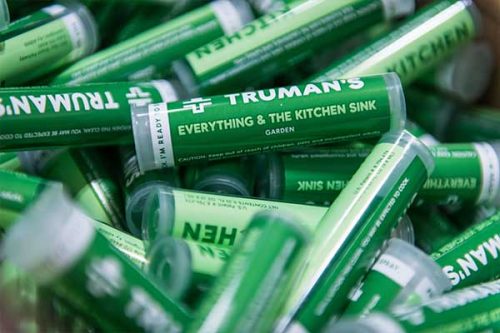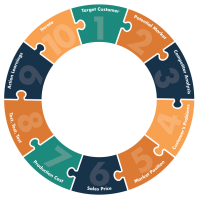Designing better business models: Truman’s & Ocean Saver

Focus on Truman’s and Ocean Saver
We look for opportunities where we can offer something better, fresher and more valuable and we seize them. We often move areas where the customer received a poor deal and where the competition is complacent. – Richard Branson
This is the approach some proactive companies are taking to shake up their particular industry. Never before have we seen so much great innovation coming from ‘the small guys’. How have they done it? What’s the process?
It all starts with how you look at the market that you are trying to enter. Do you do what everyone else is doing or do you try to achieve the same results but in a very different way?
Let’s take a look at the cleaning products market.
Walk down any cleaning product aisle in any supermarket and you will see row upon row of plastic bottles filled with liquids aiming to clean one specialist area or another with fresh fragrances galore. It is ironic that someone with the aim of cleaning, tidying and decluttering their home has to walk down one of the most cluttered and unclear sections of the supermarket to find what they are looking for. In addition to this, we are living in a time when plastic sensitivity and environmental impact is higher than ever before.
That is certainly how Truman’s in the US and Ocean Saver in the UK viewed the cleaning market. While some companies have looked at the problem and tried to find ways of making a ‘greener’ bottle or ‘greener ingredients’, these two companies are doing something different altogether.
They did not start at the existing solution but went back to the original question, the task to be done:
What does the customer want to get done?
They would like a clean house. They looked at what the customer likes and does not like about current propositions. For example, customers are saying that they want to use less plastic, they want to simply understand what product cleans what and they want to have a better impact on the environment without compromising cleaning ability.
So instead of looking at how those questions are already answered for the home user, they looked elsewhere.
Both companies realised that cleaning product sprays are 90% water. Therefore, they focussed on how to deliver the 10% that mattered. They worked on environmentally friendly concentrated cleaning solutions that could be added to water in the customer’s own home in re-usable spray containers. Truman tells us;
“We already knew that businesses don’t buy bottle after bottle of cleaning products; they use the same bottle over and over again, with concentrated refills and tap water. If it works for businesses, why shouldn’t it work for everyone?” A great example of looking for solutions in one part of the market that can be adapted and used in another.
For Ocean Saver, it was always about how to reduce plastic and that was their driving force to look for alternatives;
“At Ocean Saver we realised that if we could just provide the active ingredients to people, they would be able to reuse their plastic bottles, vastly reducing our consumption of single use plastic.”
However, that was not enough as they knew that customers had other needs as well as just using fewer plastic bottles. As a result, they remained committed to creating what the customer also needed: affordable solutions without comprising on quality or effectiveness.
Let’s compare this back to the original task the customer wanted to get done:
- Be able to clean their home
- Use less plastic
- Be better for the environment
- No compromise on cleaning power
Once the companies had a set of products that met the customer’s jobs to be done, they had to design a business model around it to 1) be able to sell them and 2) to make money from them so that the business could succeed and continue.
There are other elements of a business model that need to be considered apart from the product/service and the customer themselves: distribution, partnerships, ways of creating income and ways of controlling costs and maximising resources.
Again, both these companies looked at the traditional model – selling through supermarkets and shops (either directly or through a distributor) and decided to explore other options instead. For Truman’s, they wanted to keep their costs down whilst building a relationship with the customer, so instead of having a supermarket as a middle man they have started with a direct approach;
“From the start, we didn’t want to add to the crush of products already on store shelves — that would make absolutely no sense. We decided to sell Truman’s directly to you, because not only does it help keep costs down — no shelf rental fees — but even more important, it allows us to get constant feedback from customers and ensure we’re meeting or, hopefully, exceeding expectations.”
In addition to the direct to consumer model they have also set up a subscription service, delivered every six months. What Truman’s have done here is set up a recurring income stream and have used a cheaper, quicker to market strategy than to go via the big supermarkets first. Of course, if this method succeeds and they can prove demand and success, it will be a lot easier for them to negotiate listings with retailers if or when they decide to use a different route to sell to customers. Additionally, by encouraging a direct relationship with their customers they are set up to be able to learn and adapt quicker which will be vital to staying ahead of the competition and adapting to change.
OceanSaver have also gone down the direct to customer route but have additionally used popular eCommerce platforms to widen the distribution and accessibility to product. To aid with this they created packaging with direct delivery in mind as the Ocean Saver packaging is designed to fit through a letterbox so no signature is needed. This is also an example of looking at what can frustrate or annoy customers and solving that problem or removing that obstacle to purchase. It also has many practical advantages for the company itself too, in terms of efficiency of delivery as well as customer experience.
It remains to be seen how these companies will progress. It is a challenge to get consumers to think and act differently from what they have been used to. However, if the need is there and it is communicated to them well, the sales will follow as more people adopt to the new ways. I look forward to following both companies, both from a consumer and business point of view and I wish them all the success.






